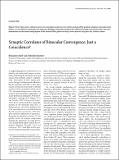Synaptic Correlates of Binocular Convergence: Just a Coincidence?
Author(s)
Scholl, Benjamin; Banerjee, Abhishek
DownloadScholl-2014-Synaptic correlates.pdf (154.0Kb)
PUBLISHER_POLICY
Publisher Policy
Article is made available in accordance with the publisher's policy and may be subject to US copyright law. Please refer to the publisher's site for terms of use.
Terms of use
Metadata
Show full item recordAbstract
A longstanding goal in neuroscience is to identify and understand synaptic mechanisms underlying the formation of neural circuits that perform sensory computations. Maturation of these circuits proceeds through developmental milestones like the critical period (CP), a time when sensory systems are patterned by afferent sensory activity. In primary visual cortex (V1), dramatic changes occur in the anatomical and functional organization of ocular preference during the CP when retinal inputs converge and compete (Katz and Crowley, 2002; Espinosa and Stryker, 2012). In V1 of mice and other mammals, neurons in the binocular zone (Fig. 1) shift preference toward the ipsilateral eye if the contralateral eye is occluded during the CP (Gordon and Stryker, 1996). Despite extensive exploration of experience-dependent mechanisms in mouse V1, the specific nature of synaptic competition shaping the formation of ocular preference in individual target neurons has remained unknown. Recently, Chen and colleagues (2014) shed light on this question by demonstrating that strong coincidence of synaptic inputs from the two eyes is restricted to the CP. Their work suggests that temporal correlations of synaptic inputs between the two eyes, accompanied by an enhancement of GABAergic transmission, are essential features of the CP (Chen et al., 2014).
Date issued
2014-07Department
Massachusetts Institute of Technology. Department of Brain and Cognitive Sciences; Picower Institute for Learning and MemoryJournal
Journal of Neuroscience
Publisher
Society for Neuroscience
Citation
Scholl, B., and A. Banerjee. “Synaptic Correlates of Binocular Convergence: Just a Coincidence?” Journal of Neuroscience 34, no. 27 (July 2, 2014): 8931–8933.
Version: Final published version
ISSN
0270-6474
1529-2401